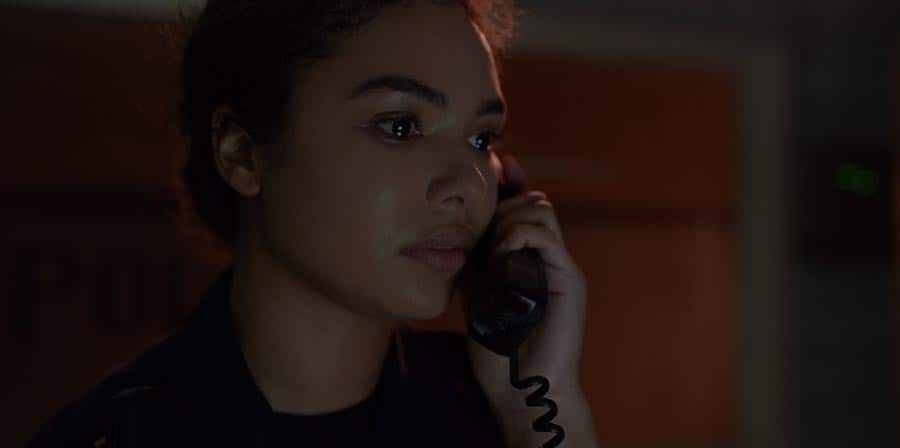Plot: On a search to uncover the mysterious circumstances surrounding her father’s death, a newly appointed police officer, Jessica Loren is assigned to the last shift in a decommissioned police station where a notoriously vicious cult saw their demise years prior. The lone officer at the station, she soon finds herself barraged by terrifying paranormal events, and in the process, is taken on a journey during which she learns the shocking truth behind her family’s entanglement with a demented cult leader.
Review: Reboots are nothing new these days, but rarely do you find a filmmaker who remakes his own film released not even ten years prior. Anthony DiBlasi, a protege of Clive Barker who has produced or directed three adaptations of the British author’s writing, released Last Shift in 2014. The little-seen flick, written by DiBlasi and Scott Polley, followed a rookie cop witnessing supernatural events in a police station. Incorporating cults, demons, and copious amounts of gore, Last Shift was already a decent horror movie but one DiBlasi wanted to expand and revisit. Hitting theaters this past weekend, Malum follows the core plot of Last Shift very closely but with significant changes to the visual tone of the project. Malum is not so much a reboot as it is a reimagining of Last Shift and an interesting experiment in how small changes can alter the finished product.


Clocking in at just about five minutes longer than Last Shift, Malum still centers on a police officer named Jessica Loren (Jessica Sul) who volunteers to work the final shift at a police station being shut down. The station, which was the same one her father was stationed at when he died a year before, is vacant and plagued by a spate of murders that occurred there, including Jessica’s father, who was the lead cop in the apprehension of John Malum (Chaney Morrow) and his cult. Jessica wants to know how and why her father died and begins to uncover details about the Malum cult and how her family is connected. As the night progresses, strange moments evolve into a horrifying nightmare that draws on the body horror of Clive Barker, the elder gods of H.P. Lovecraft, and the visceral films of John Carpenter for an atmospheric bloodbath.
With the core narrative the same, Malum expands on the supernatural elements of Last Night and adds new characters while changing others. Candace Coke plays Diane, Jessica’s mother, giving a different motivation for the character to volunteer for the last shift at the station. The cult leader here is named Malum (Latin for Evil), whereas the 2014 film had a character named John Paymon. Since Hereditary was released between the two versions of this story, Paimon has a different connotation and necessitated the new title. Austin Schmidt’s cinematography gets a boost from Sean McDaniel, while Samuel Laflamme’s eerie score blows away the lackluster music from Adam Barber. Welcome Villain Films also ponied up a bigger budget, elevating this movie from being just another cheap horror film with production values far superior to Last Shift. The demonic makeup alone is quite good, especially the monstrous faces in the film’s final act.
While this movie has a bigger budget, your expectations should remain firmly in check. Malum is through and through a low-budget horror film that happens to have the sheen of a higher-end production. The first thirty minutes are dialogue-heavy and, despite an exceptional lead turn by Jessica Sula, comes across as thinly written. The characters talk in a way that never feels truly authentic, and the plotting requires a substantial investment from the viewer to connect where the story is headed. Once the lights begin to flicker and the jump scares start in earnest, Malum plays firmly by the conventions of the genre. The gore is well done, and the camerawork accentuates the surreal character designs of the cultists and their demonic gods. That means that Malum is less scary than gross, with the scares less surprising and simply loud.
Anthony DiBlasi builds the tension in the first hour with teases that do not always pay off before the film descends into a hellscape of a final act that throws everything at the screen, whether it makes sense or not. Much of the twists that gave Last Shift such a haunting ending are not adequately explained here, giving the ending of Malum a degree of ambiguity. But, having seen Last Shift, I felt the original movie’s conclusion resonated more than it does in Malum. The ending is still a solid twist but will sit differently with audiences who are going into this movie fresh and without having seen the 2014 original. DiBlasi’s work here shows growth as a filmmaker compared to what he did in Last Shift, but Malum also feels like the jump George Lucas took from his student film to the feature version of THX-1138: the roots are the same, but they are not the same movie.
With fans and critics lauding the “elevated horror” of the last decade, Malum revels in the old-school grit of films like Prince of Darkness, Assault on Precinct 13, and the works of Dario Argento. This is not a tentpole horror movie aiming for awards but a grisly bloodbath of a flick that wants to make you squirm and revel in the evil lurking in the shadows. From solid physical effects to some more unique creature designs in recent memory, Malum is awash in creeps and horrors. It may not be the most original or unique horror movie of the year, but it is a step above most of what is out there. Anthony DiBlasi could make a career by remaking this movie every few years with slight changes to the mood, tone, and atmosphere. Based on the differences between Last Shift and Malum, I would definitely be up for a third round of this story.